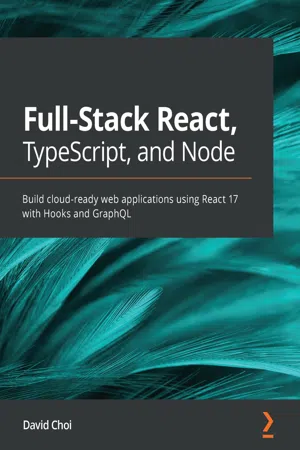
Full-Stack React, TypeScript, and Node
Build cloud-ready web applications using React 17 with Hooks and GraphQL
- 648 pages
- English
- ePUB (mobile friendly)
- Available on iOS & Android
Full-Stack React, TypeScript, and Node
Build cloud-ready web applications using React 17 with Hooks and GraphQL
About this book
Discover the current landscape of full-stack development and how to leverage modern web technologies for building production-ready React.js applications to deploy on AWS
Key Features
- Understand the architecture of React and single-page applications
- Build a modern Web API for your SPA using Node.js, Express, and GraphQL
- Gain a clear and practical understanding of how to build a complete full-stack application
Book Description
React sets the standard for building high-performance client-side web apps. Node.js is a scalable application server that is used in thousands of websites, while GraphQL is becoming the standard way for large websites to provide data and services to their users. Together, these technologies, when reinforced with the capabilities of TypeScript, provide a cutting-edge stack for complete web application development.
This book takes a hands-on approach to implementing modern web technologies and the associated methodologies for building full-stack apps. You'll begin by gaining a strong understanding of TypeScript and how to use it to build high-quality web apps. The chapters that follow delve into client-side development with React using the new Hooks API and Redux. Next, you'll get to grips with server-side development with Express, including authentication with Redis-based sessions and accessing databases with TypeORM. The book will then show you how to use Apollo GraphQL to build web services for your full-stack app. Later, you'll learn how to build GraphQL schemas and integrate them with React using Hooks. Finally, you'll focus on how to deploy your application onto an NGINX server using the AWS cloud.
By the end of this book, you'll be able to build and deploy complete high-performance web applications using React, Node, and GraphQL.
What you will learn
- Discover TypeScript's most important features and how they can be used to improve code quality and maintainability
- Understand what React Hooks are and how to build React apps using them
- Implement state management for your React app using Redux
- Set up an Express project with TypeScript and GraphQL from scratch
- Build a fully functional online forum app using React and GraphQL
- Add authentication to your web app using Redis
- Save and retrieve data from a Postgres database using TypeORM
- Configure NGINX on the AWS cloud to deploy and serve your apps
Who this book is for
The book is for web developers who want to go beyond front-end web development and enter the world of full-stack web development by learning about modern web technologies and how they come together. A good understanding of JavaScript programming is required before getting started with this web development book.
Frequently asked questions
- Essential is ideal for learners and professionals who enjoy exploring a wide range of subjects. Access the Essential Library with 800,000+ trusted titles and best-sellers across business, personal growth, and the humanities. Includes unlimited reading time and Standard Read Aloud voice.
- Complete: Perfect for advanced learners and researchers needing full, unrestricted access. Unlock 1.4M+ books across hundreds of subjects, including academic and specialized titles. The Complete Plan also includes advanced features like Premium Read Aloud and Research Assistant.
Please note we cannot support devices running on iOS 13 and Android 7 or earlier. Learn more about using the app.
Information
Section 1:Understanding TypeScript and How It Can Improve Your JavaScript
- Chapter 1, Understanding TypeScript
- Chapter 2, Exploring TypeScript
- Chapter 3, Building Better Apps with ES6+ Features
Chapter 1: Understanding TypeScript
- What is TypeScript?
- Why is TypeScript necessary?
Technical requirements
What is TypeScript?
- The language is a feature-rich, statically typed programming language that adds true object-oriented capabilities to JavaScript.
- The compiler converts TypeScript code into native JavaScript, but also provides the programmer with assistance in writing code with fewer errors.
Why is TypeScript necessary?
- Let's install Node first. You can download Node from here: https://nodejs.org/. Node gives us npm, which is a JavaScript dependency manager that will allow us to install TypeScript. We'll dive deep into Node in Chapter 8, Learning...
Table of contents
- Full-Stack React, TypeScript, and Node
- Why subscribe?
- Preface
- Section 1:Understanding TypeScript and How It Can Improve Your JavaScript
- Chapter 1: Understanding TypeScript
- Chapter 2: Exploring TypeScript
- Chapter 3: Building Better Apps with ES6+ Features
- Section 2: Learning Single-Page Application Development Using React
- Chapter 4: Learning Single-Page Application Concepts and How React Enables Them
- Chapter 5: React Development with Hooks
- Chapter 6: Setting Up Our Project Using create-react-app and Testing with Jest
- Chapter 7: Learning Redux and React Router
- Section 3: Understanding Web Service Development Using Express and GraphQL
- Chapter 8: Learning Server-Side Development with Node.js and Express
- Chapter 9: What is GraphQL?
- Chapter 10: Setting Up an Express Project with TypeScript and GraphQL Dependencies
- Chapter 11: What We Will Learn – Online Forum Application
- Chapter 12: Building the React Client for Our Online Forum Application
- Chapter 13: Set Up a Session State Using Express and Redis
- Chapter 14: Setting Up Postgres and a Repository Layer with TypeORM
- Chapter 15: Adding GraphQL Schema Part I
- Chapter 16: Adding a GraphQL Schema – Part II
- Chapter 17: Deploying an Application to AWS
- Other Books You May Enjoy